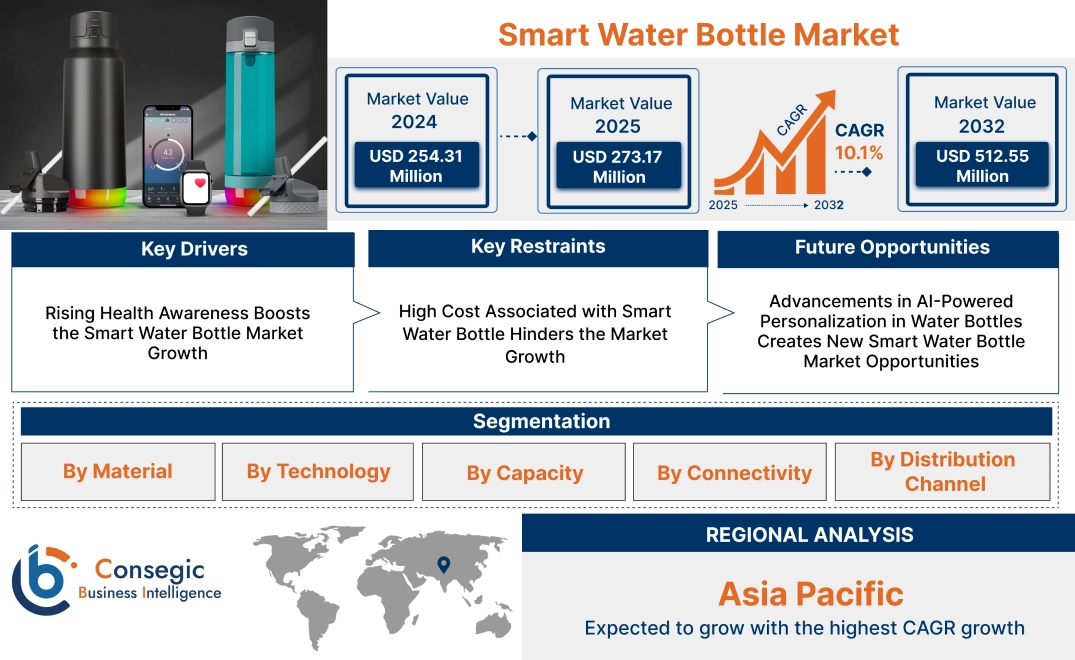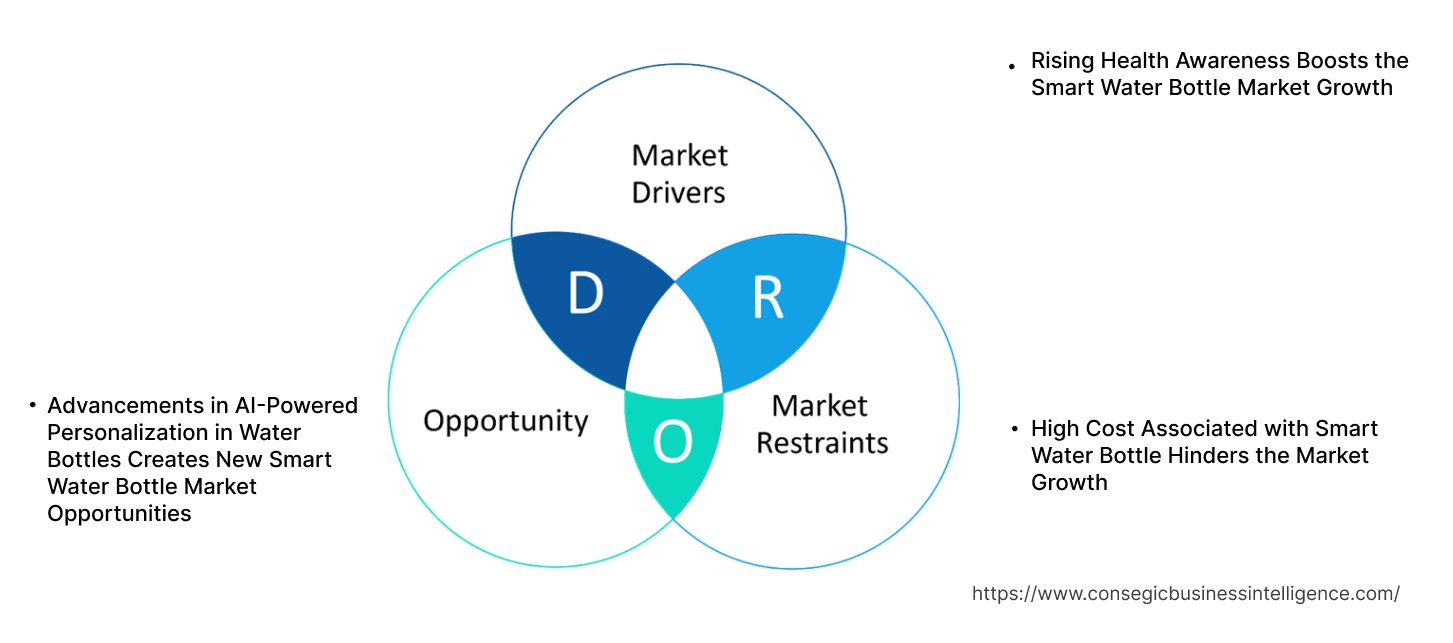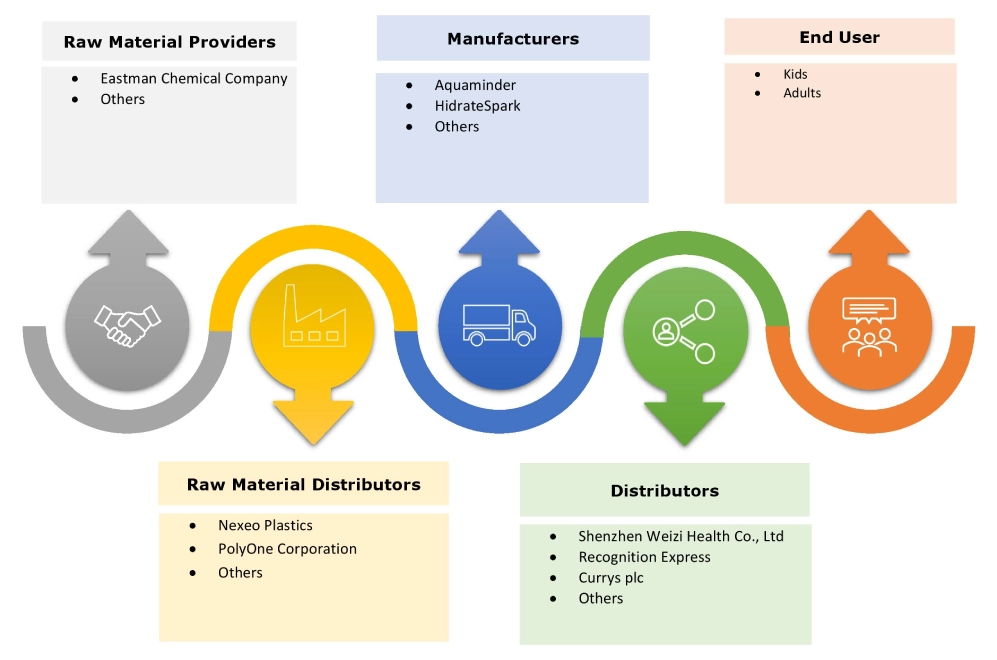- Summary
- Table Of Content
- Methodology
Smart Water Bottle Market Size:
Smart Water Bottle Market size is estimated to reach over USD 512.55 Million by 2032 from a value of USD 254.31 Million in 2024 and is projected to grow by USD 273.17 Million in 2025, growing at a CAGR of 10.1% from 2025 to 2032.
Smart Water Bottle Market Scope & Overview:
Smart water bottles are equipped with sensors, lights, and connectivity technology. These bottles track hydration levels and provide a remainder for water intake. These bottles are designed for long performance and durability. Moreover, these bottles have insulated materials that allow them to retain temperature for long hours. These bottles are integrated with smartphones for enhanced health monitoring and overall user experience. The integration of these bottles with smartphones allows users to set hydration goals, set reminders, and track hydration progress. This increases the overall productivity and health of the user.
Key Drivers:
Rising Health Awareness Boosts the Smart Water Bottle Market Growth
There is a growing interest and awareness in health monitoring and maintenance across the globe. As more people focus on fitness, there is awareness about hydration levels and adequate water intake. Low water intake causes dehydration, which in turn causes severe headaches, fever, organ failure, and other chronic effects on the body. Smart water bottles assist users in maintaining water intake by giving timely reminders in smartphone applications or glowing lights.
- For instance, according to research published on National Center for Biotechnology Information in October 2022, 75% of Americans are chronically dehydrated. Moreover, this occurred in 17% to 28% of older adults.
Thus, as per the market analysis, the aforementioned factors are boosting the usage of these water bottles, in turn driving the smart water bottle market trends.
Key Restraints:
High Cost Associated with Smart Water Bottle Hinders the Market Growth
Smart water bottles have high costs primarily due to advanced technologies integrated with the bottles. This includes sensors, connectivity technologies, and smartphone applications.
Moreover, costs associated with the manufacturing, transportation, and raw materials of these bottles increases the overall costs. Furthermore, the high defective rate due to an underdeveloped industrial supply chain is another factor for the additional costs. Thus, the market analysis shows that the aforementioned factors are restraining the smart water bottle market demand.
Future Opportunities:
Advancements in AI-Powered Personalization in Water Bottles Creates New Smart Water Bottle Market Opportunities
Integration of advanced technologies into smart bottles enhances performance and efficiency. AI-integrated bottles provide personalized remainders based on the data collected by the sensors. This includes providing real-time hydration recommendations primarily based on the user’s activity levels, sleep patterns, environmental factors, and diet data. Moreover, this also includes integrated nutritional analysis, allowing users to also track the nutrients consumed.
- For instance, in October 2024, Gatorade launched a generative AI squeeze bottle personalization platform. This platform enables athletes to personalize water bottles in unique designs and styles.
Thus, the ongoing advancements in AI-powered customization in smart bottles are projected to drive smart water bottle market opportunities during the forecast period.
Smart Water Bottle Market Segmental Analysis :
By Material:
Based on the material, the market is segmented into plastic, stainless steel, polyester, glass, and others.
Trends in the Material:
- Rising trend in the adoption of glass bottles due to their eco-friendly properties and effective insulation.
The stainless-steel segment accounted for the largest revenue share in the market in 2024.
- The stainless-steel bottles are durable, strong, recyclable, corrosion-resistant, and reusable. These bottles are easy to clean and available in various sizes.
- Moreover, these bottles do not retain any taste or odor, keeping the water fresh for a longer time. These bottles do not contain any chemicals and are highly sustainable.
- For instance, Aquaminder offers stainless steel double-wall smart water bottles in its product portfolio. These bottles offer advanced temperature retention, keeping beverages hot for up to 12 hours and cold for up to 24 hours.
- Therefore, as per the market analysis, the benefits offered by stainless-steel bottles are driving the smart water bottle market trends.
The plastic segment is expected to register the fastest CAGR during the forecast period.
- The plastic smart bottles use plastic that is free from BPA and other harmful chemicals. These bottles are durable and more cost-effective.
- Plastic bottles are heat resistant and can withstand high temperatures of water. Also, these bottles can be molded into different shapes and sizes.
- For instance, Hidrate offers HidrateSpark TAP made up of Tritan plastic. The water bottle enables users to sync information using tapping the smartphone on the NFC tag.
- Thus, the above benefits offered by plastic bottles are further driving their adoption, in turn propelling the market during the forecast period.
By Technology:
Based on the technology, the market is bifurcated into sensors and lights.
Trends in the Technology:
- Rising adoption of water bottles that use lights due to their simplicity and affordability.
- Increasing usage of sensors in water bottles to provide exact, accurate data is boosting the smart water bottle market size.
The sensors segment accounted for the largest revenue in the smart water bottle market share in 2024.
- The sensors in water bottles detect the amount of water drunk, drinking frequency, the temperature of water in the bottle, and water level height, among others.
- These sensors record the data that is visualized and displayed on the screen display on the bottle or the smartphone application that is connected to the bottle. This data is utilized for personal recommendations and remainders.
- For instance, WaterH offers a WaterH Boost Lite smart water bottle. It comprises sensors to track exact hydration levels, and it is compatible with Apple Health and Fitbit.
- Therefore, the increasing advancements associated with sensor-integrated water bottles are driving the smart water bottle market growth.
The lights segment is expected to register the fastest CAGR during the forecast period.
- The smart bottles use lights as a signal to remind the user to drink water and stay hydrated.
- These bottles measure the time intervals in water intake, and hydration level based on activity levels to give remainders by glowing.
- For instance, EQUA offers sustainable smart water bottles in its product offerings. These bottles glow to remind the user to drink water.
- Thus, the benefits offered by light-integrated smart bottles are expected to propel the smart water bottle market expansion during the forecast period.
By Capacity:
Based on the capacity, the market is trifurcated into up to 750 ml, 750 to 1500 ml, and above 1500 ml.
Trends in the Capacity:
- Rising adoption of above 1500 ml water bottles for outdoor usage is boosting the smart water bottle market size.
- Increasing shift towards the adoption of water bottles up to 750 ml, due to their lightweight properties.
The up to 750 ml segment accounted for the largest revenue in the smart water bottle market share in 2024.
- Up to 750 ml water bottles are convenient, easy to handle, lightweight, and cost-effective.
- Moreover, water bottles up to 750 ml capacity are useful for kids and indoor applications.
- For instance, Porodo offers smart water bottles of 500 ml capacity in its product offerings. This bottle is integrated with a temperature indicator.
- Therefore, wide usage of water bottles up to 750 ml capacity is driving the smart water bottle market demand.
The 750 to 1500 ml segment is expected to register the fastest CAGR during the forecast period.
- The 750 to 1500 ml water bottles store large quantities of water allowing the users to stay hydrated without constant need to refill the water.
- Water bottles with capacity ranging from 750 to 1500 ml are useful for workplaces, colleges, gyms, and workout sessions.
- For instance, Aquaminder offers a 1.2-liter smart bottle in its product portfolio. This comes with a detachable base and advanced temperature retention.
- Thus, the advantages of higher capacity bottles are driving the adoption of 750 to 1500 ml water bottles, in turn proliferating the market during the forecast period.
By Connectivity:
Based on the connectivity, the market is trifurcated into Bluetooth, Wi-Fi, and NFC.
Trends in the Connectivity:
- Rising adoption of water bottles with NFC technology for one-tap use is boosting the market demand.
- Increased usage of Wi-Fi-based water bottles due to its ability of seamless data integration.
The Bluetooth segment accounted for the largest revenue share of 72.09% in the market in 2024.
- The Bluetooth-enabled water bottle uses Bluetooth technology to transmit data to the smartphone application including water intake, daily water goals based on the user’s activity, and real-time updates on progress.
- Moreover, this increases the productivity, and hydration levels of the user providing an enhanced user experience.
- For instance, Botell offers a smart bottle and an application that records data using Bluetooth. This also offers real-time measurement and glows to remind users.
- Therefore, the smart water bottle market analysis depicts that the benefits offered by Bluetooth-enabled water bottles are driving the market trends.
The Wi-Fi segment is expected to register the fastest CAGR during the forecast period.
- The Wi-Fi technology uses wireless connectivity to connect water bottles to a smartphone application. This enables users to have real-time and regular updates using the data collected by the bottle.
- For instance, Deluxe CCTV Video Surveillance offers a Gym water bottle with a 4k UHD Wi-Fi camera. This is a battery-operated bottle offering data integration using a smartphone application and Wi-Fi.
- Thus, the advantages of -enabled water bottlesare propelling the market during the forecast period.
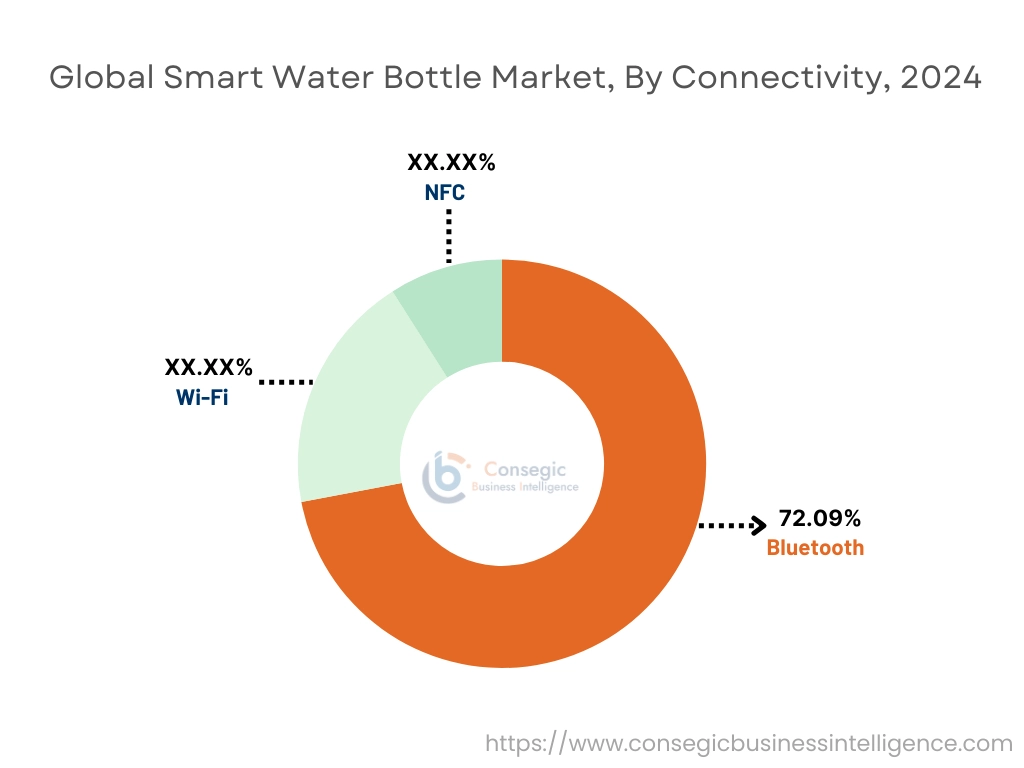
By Distribution Channel:
Based on the distribution channel, the market is bifurcated into online and offline.
Trends in the Distribution Channel:
- Increasing adoption of offline shopping to enable buyers to check quality, color, and features before purchasing the bottle.
- Rising integration of personalized recommendations in online shopping platforms enhances user engagement, boosting the market growth.
The offline segment accounted for the largest revenue share in the market in 2024.
- The offline distribution channels are the physical retail stores and authorized resellers in the market.
- The users get a hands-on product experience and immediate availability of the product.
- The users have the opportunity to test products and look for different options in one place.
- Therefore, advantages offered by offline channels are driving the smart water bottle market expansion.
The online segment is expected to register the fastest CAGR during the forecast period.
- The online distribution channels include e-commerce platforms, official company websites, or online marketplaces.
- These platforms offer several benefits such as increased convenience, wider options, lower prices, easy returns, higher offers and discounts, product variety, and various payment options among others.
- Moreover, consumers are also able to check reviews and ratings to ensure quality checks and experience before purchasing the product.
- Thus, the above benefits associated with online distribution channel are projected to drive the market during the forecast period.
Regional Analysis:
The regions covered are North America, Europe, Asia Pacific, the Middle East and Africa, and Latin America.
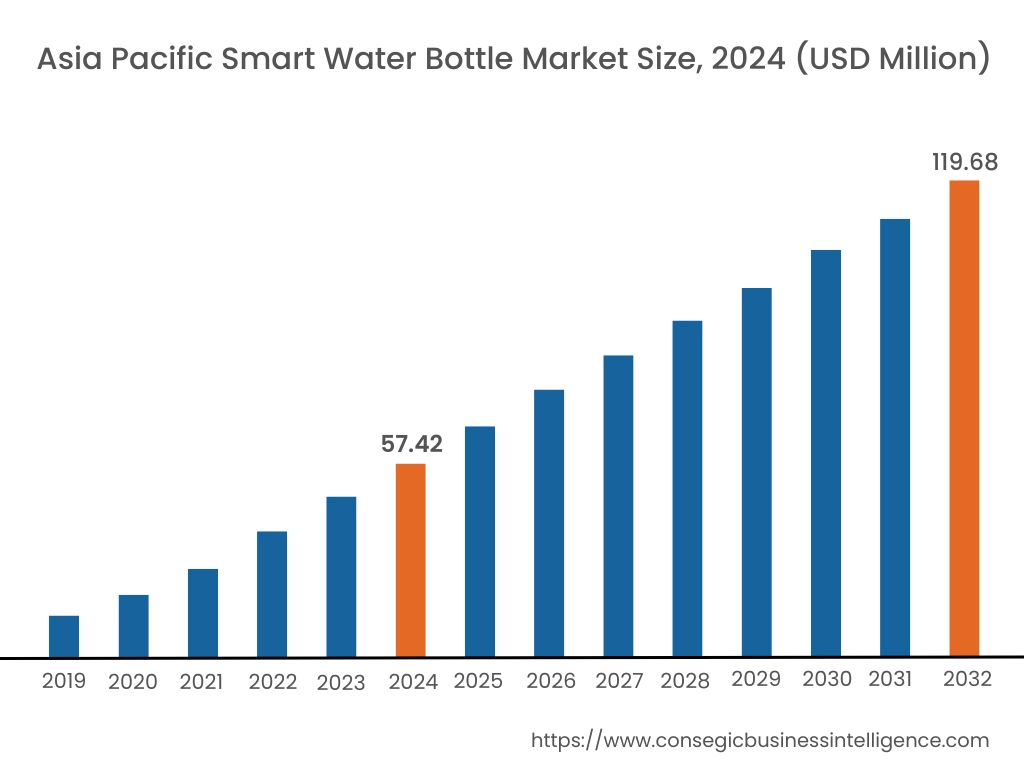
Asia Pacific region was valued at USD 57.42 Million in 2024. Moreover, it is projected to grow by USD 61.85 Million in 2025 and reach over USD 119.68 Million by 2032. Out of this, China accounted for the maximum revenue share of 39.2%. The market growth in the region is driven by rising awareness among adults regarding health, rising sports industry, and the growing demand for smart solutions to stay hydrated.
- For instance, in November 2023, Xiaomi launched its Mijia smart electric hot water bottle 5L in China. It offers temperature control using a touch panel or an application.
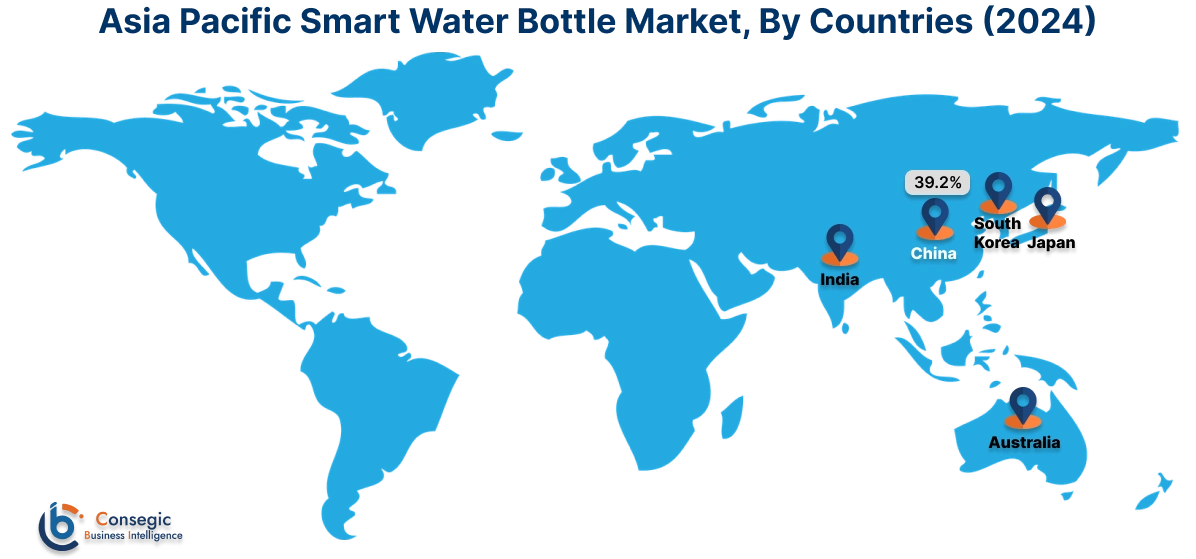
North America is estimated to reach over USD 194.77 Million by 2032 from a value of USD 97.26 Million in 2024 and is projected to grow by USD 104.42 Million in 2025. The smart water bottle market analysis shows that the market in the region is expanding due to its well-established healthcare sector and the rising consumer awareness regarding health benefits of water intake.
- In October 2022, Gatorade a US based company launched a Smart Ex bottle. This bottle is specially designed for athletes for daily hydration recommendations.
In Europe, the market growth is driven by rising technological advancements, leading to higher adoption of these water bottles in the region. The market growth in the Middle East Africa and Latin America is due to rising disposable income, allowing individuals to focus on healthier and smarter options in water bottles.
Top Key Players and Market Share Insights:
The smart water bottle industry is highly competitive with major players providing products to the national and international markets. Key players are adopting several strategies in research and development (R&D), product innovation, and end-user launches to hold a strong position in the global smart water bottle market. Key players in the smart water bottle industry include -
- Hamilton Housewares Pvt. Ltd. (India)
- HidrateSpark (US)
- EQUA (Sweden)
- LARQ (US)
- Koninklijke Philips N.V. (Netherlands)
- Monos (Canada)
- LitFlask (US)
- Aquaminder (India)
- Drinkbot (India)
- RE-COMPANY S.A. (Switzerland)
Recent Industry Developments :
Product Launches:
- In January 2025, Echo Water announced its first smart hydrogen water bottle and application. It has personalized tracking along with the ability to generate hydrogen directly into the bottle.
- In November 2022, AQUAME launched a smart water bottle. This bottle monitors the daily water intake of a person and monitors the hydration levels.
Smart Water Bottle Market Report Insights :
| Report Attributes | Report Details |
| Study Timeline | 2019-2032 |
| Market Size in 2032 | USD 512.55 Million |
| CAGR (2025-2032) | 10.1% |
| By Material |
|
| By Capacity |
|
| By Connectivity |
|
| By Distribution Channel |
|
| By Region |
|
| Key Players |
|
| North America | U.S. Canada Mexico |
| Europe | U.K. Germany France Spain Italy Russia Benelux Rest of Europe |
| APAC | China South Korea Japan India Australia ASEAN Rest of Asia-Pacific |
| Middle East and Africa | GCC Turkey South Africa Rest of MEA |
| LATAM | Brazil Argentina Chile Rest of LATAM |
| Report Coverage |
|
Key Questions Answered in the Report
How big is the smart water bottle market? +
Smart Water Bottle Market size is estimated to reach over USD 512.55 Million by 2032 from a value of USD 254.31 Million in 2024 and is projected to grow by USD 273.17 Million in 2025, growing at a CAGR of 10.1% from 2025 to 2032.
What are the major segments covered in the smart water bottle market report? +
The segments covered in the report are material, technology, capacity, connectivity, and distribution channels.
Which region holds the largest revenue share in 2024 in the smart water bottle market? +
North America holds the largest revenue share in the smart water bottle market in 2024.
Who are the major key players in the smart water bottle market? +
The major key players in the market are Hamilton Housewares Pvt. Ltd. (India), HidrateSpark (US), EQUA (Sweden), LARQ (US), Koninklijke Philips N.V. (Netherlands), Monos (Canada), LitFlask (US), Aquaminder (India), Drinkbot (India), and RE-COMPANY S.A. (Switzerland).
